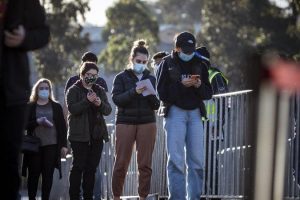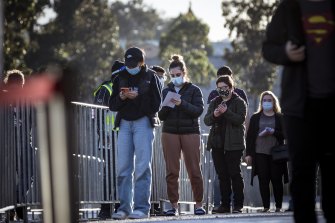Victorian outbreak grows quicker than NSW, but tide may be turning

For our free coronavirus pandemic coverage, learn more here.
Victoria’s COVID-19 outbreak has grown more quickly than NSW’s since Melbourne’s sixth lockdown began but a number of key measures have trended down in recent days suggesting to some experts that the spread of the Delta strain could be controlled.
Total cases, mystery cases and the crucial reproduction number – the average number of people each infected person passes the virus onto – have dropped for two days in a row, but the work of the state’s contact tracers is being hampered back by people who test positive up to eight days after first feeling symptoms.
People line up for vaccinations in Melbourne on Wednesday. The federal government wants to open up bookings to whole families in a bid to further speed up the rollout.Credit:Chris Hopkins
Mikhail Prokopenko, director of the University of Sydney’s centre for complex systems, said Victoria’s number of mystery cases suggested it remained “on the brink” despite the fall in daily infections.
He said Victoria New Zealand which is battling its own fast-moving outbreak, were now being watched by the rest of the world to see whether they could rein in a Delta outbreak that had led to widespread community spread – a feat which had only so far been achieved in China.
“I have my doubts,” Professor Prokopenko said. “But I also still have hope it is possible.”
University of South Australia epidemiologist Adrian Esterman said the rate of case growth over the past few weeks had been worrying, but that the government’s swift decision to lock down and the subsequent tightening of rules meant he was “cautiously optimistic” the Victorian outbreak could be controlled.
The total number of cases in the outbreak has multiplied by four in the weeks since it entered this month’s lockdown, with the total number of cases growing from 221 (which had hung over from the fifth lockdown) to 878. Over the same period, NSW’s caseload multiplied by 3.6, going from 4077 to 14,673.
Victoria recorded 45 cases on Wednesday, down from 71 and 50 in preceding days. There were nine mystery cases, down from 22 on Monday and 17 cases were in isolation for their entire infectious period – a metric that will be key to Victoria’s reopening.
Health Minister Martin Foley said it was heartening cases had dropped but authorities still had work to do to gain control of the spread. “We know numbers bounce around,” he said.
The total number of cases in the state with an unknown source dropped from 47 to 46 on Wednesday despite the nine mystery cases. This indicates contact tracers linked 10 cases that previously had an unknown source.
Ten of Wednesday’s cases were associated with a Broadmeadows childcare centre, nine were linked to the Royal Melbourne Hospital and Shepparton clusters, four were grouped with the Hobsons Bay cluster, two were from the CBD and North Melbourne, one was linked to a Glenroy primary school and 10 were household contacts of known cases.
NSW’s daily case numbers rose to a record 919 on Wednesday and two more deaths were recorded including a woman in her 30s and a man in his 80s.
Authorities on Wednesday pleaded with Victorians to get tested as soon as they felt symptoms to shorten the period during which they posed a danger to others. Health Department deputy secretary Kate Matson said some people were testing positive eight days after first feeling COVID-19 symptoms, compared with an average for Victoria’s mystery cases of three days. “If we shorten that, we will be able to get on top of this,” Ms Matson said.
Professor Prokopenko said of Melbourne’s outbreak: “What worries me most is the number of mystery cases continues to grow each day even with [the] harshest restrictions. It tells me lockdown isn’t enough.”
Calculations by Professor Esterman show that Victoria’s reproduction rate is 1.3, meaning on average, every 10 people with COVID will infect 13 others. In NSW the rate is 1.2. He said the rate of reproduction in Victoria had fallen from almost 2.5 in recent days but the trend would need to continue for more days to provide certainty that the tide has turned.
“We can be cautiously optimistic,” he said.
Victorian authorities hope its toughened lockdown, which began last week, will continue to bring the reproduction rate down.
Deakin University chair in epidemiology Catherine Bennett said Victoria’s outbreak had grown more quickly than NSW’s. Professor Bennett said NSW had been able to bring its outbreak within relative control, and while the overall daily numbers had not dropped, its reproduction rate had stayed stable.
When it comes to vaccinations, Victoria has some way to go to catch up with NSW. Victoria is only vaccinating 75,000 people per day compared to 130,000 in NSW.
More than 1.3 million Victorians attempted to call the state’s vaccine booking line on Wednesday morning as Pfizer eligibility opened up for under-40s. By 5pm, more than 95,000 people had booked appointments and the vaccination website was experiencing long delays. Hundreds of thousands of booking spots still remain free.
Mr Foley said he would not rule out implementing even tougher NSW border measures in light of NSW’s “deteriorating” position.
“We can’t send it back – I wish we could – but what we can do is take all the measures [the] public health team recommend to us to keep that border protection as strong as possible,” he said.
In response to a question about whether it was possible Victoria’s border could stay closed to NSW when 70 or 80 per cent of the population were vaccinated, he said: “How long is a piece of string?”
“Let’s see what the world is shaped [like], let’s see what the position in NSW [is] when we as a nation, get to 70 and 80 per cent,” he said.
Stay across the most crucial developments related to the pandemic with the Coronavirus Update. Sign up to receive the weekly newsletter.
Most Viewed in National
From our partners
Source: Read Full Article

